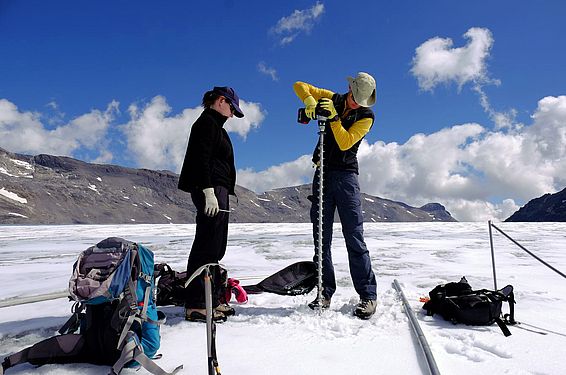Climate change caused by human activity under a high-emissions scenario may halve the area covered by glaciers outside the Antarctic and Greenland ice sheets by the end of the century, reports a study published in Nature. This retreat could create novel ecosystems covering an area between the size of Nepal and Finland by the year 2100. Understanding these post-glacial ecosystems creates a new focus for researchers that sits alongside continued efforts to mitigate further glacial decline.
One of the consequences of human-caused climate change is the shrinkage of glaciers, which causes a rapid ecological shift as novel ecosystems develop to fill emerging new habitat. However, analyses of this change at a global scale are lacking.
Jean-Baptiste Bosson of the Conservatory of natural areas of Haute-Savoie and Matthias Huss of the WSL use a global glacier evolution model to examine the predicted twenty-first century trajectory of 650,000 km2 of glaciers found outside the Antarctic and Greenland ice sheets. Glacier outlines, digital elevation models of subglacial terrain, and climatic data are used to predict the response of each individual glacier to climate scenarios until 2100. In addition, the model is able to predict the characteristics of emerging ecosystems in deglaciated areas, which were classified into marine, freshwater or terrestrial categories.
This modelling predicts that deglaciation will occur at a similar rate regardless of the climate scenario until 2040, after which estimates diverge depending on the severity of emission release. Under a high-emissions scenario (in which global greenhouse gas emissions triple by 2075), about half of 2020 glacier area could be lost by 2100. However, this could be curbed by a low-emissions scenario (in which net zero is achieved by 2050), which would reduce this loss to approximately 22%. Deglaciation is predicted to expose an area of land between roughly the size of Nepal (149,000 ± 55,000 km2) and Finland (339,000 ± 99,000 km2) by the end of the century, with these habitats being classified as 78% terrestrial, 14% marine and 8% freshwater. These areas could provide refuge for cold-adapted species displaced by warming elsewhere.
The authors argue that, as well as limiting deglaciation, resources and focus should be given to protecting these newly forming ecosystems to secure their future.
(this text is the original Nature press release)
Always up to date: Subscribe to the WSL Newsletter
Contact ¶
Originalpublikation ¶
Copyright ¶
WSL and SLF provide image and sound material free of charge for use in the context of press contributions in connection with this media release. The transfer of this material to image, sound and/or video databases and the sale of the material by third parties are not permitted.

